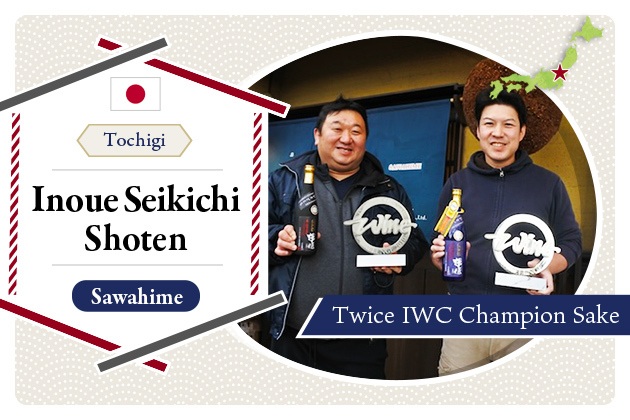
2024.02
14
New Tales of Off-flavors: Past and Present Stories of Two Sake Breweries (Part2)
With the diversification of sake styles, there is a growing trend to view flavors that were previously considered off-flavors as specific and part of a new sake style.
In the first instalment of the series New Tales of Off-flavors, Yosuke Kawase, product development manager at Clear Inc., provided us with a traditional view of off-flavors.
In this second installment, we interviewed two sake breweries about their efforts to incorporate, what some consider off-flavors, into their sake. We interviewed two breweries: Kenbishi Sake Brewery in Hyogo Prefecture, which has designed a flavor that embraces hineka (aged aroma), and Yama no Kotobuki in Fukuoka Prefecture, which is taking on the challenge of creating a flavor that has never before been seen in Japanese sake.
Kenbishi: Brewing sake focused on aged aroma
Producing a lot of acidity and amino acids
Kenbishi Sake Brewery, which specializes in aged sake, makes sake that produces hineka, an aged aroma that occurs during the aging process. Masataka Shirakashi, president of the brewery, began by explaining the chemical changes that occur during the aging process.
“We believe that aged aroma is the result of five reactions: Maillard reaction, Strecker degradation, ester bonding, vanillin generation, and DMTS (dimethyl trisulfide) generation.
Maillard reaction is a reaction of heat, amino acids, and sugars that produces a color change and a rich, chocolate-like flavor. Strecker degradation occurs as a side reaction of the Maillard reaction and produces a savory aroma reminiscent of nuts or hojicha tea. Ester bonding is a heat-independent change in acidity that produces a honey-like aroma. Vanillin gives off a vanilla-like aroma. And DMTS smells like sulfur and pickles, which people don't like.”
The key to creating the Kenbishi flavor is to separate the Maillard and Strecker reactions, which are caused by heat, from the ester bonds, vanillin, and DMTS, which also occur at low temperatures.
If you drink sake that has been aged for a long time at minus 5℃ (23°F), you will notice that many of them have a strong honey-like aroma. That flavor is created because the temperature is low, preventing the Maillard reaction and Strecker degradation from taking place. But DMTS does occur.
We emphasize the Maillard reaction from heat; DMTS can have a spicy, curry-like nuance, if only perceived in trace amounts. We can balance the aroma of DMTS by adding a caramelized aroma from the Maillard reaction.”
In order to achieve the ideal maturation process, Kenbishi brews sake that produces high levels of acidity and amino acids. The brewery uses a Yamahai method of yeast starter to produce high acidity, strong koji to saccharify the rice, and strong yeast to finish off the saccharification. This facilitates the formation of ester bonds and Maillard reactions.
“However, sake with a lot of acidity and amino acids is not drinkable when it is fresh. So we make it our goal every year to get the lowest rank in Nada's shinshu (new sake) competition (laughs).”
Kenbishi compose the flavor and aroma, anticipating how they will come together over time, based on the assumption that they will change as the sake ages. In addition, blending, an important process in Kenbishi, also plays a major role in adjusting the balance of these flavors and aromas.
Changes in off-flavor for 500 years
Founded in 1505, the Kenbishi Sake Brewery has been brewing sake without change, but has the concept of off-flavors such as hineka been around since then?
“ At that time, aged sake was a higher quality product, and we even have a record of a complaint from a customer who said, 'Don't mix old sake with new sake.' Therefore, the aged aroma would not have been regarded as bad as it is today. I have not seen any documents analyzing the aroma in detail in the past. Since the technology was not yet developed at that time, when sake brewing failed, it was extreme, such as when the added shochu gave off a strong odor, or when bacteria turned sake sour, and so on.”
It has long been thought that taru-zake (sake made in cedar barrels) may have been used to cover up the aged aroma, but Shirakashi said, “Barrels came into use because they were inexpensive and large enough to make, suitable for mass transportation by ship. People also transported soy sauce and miso in barrels, so it is unlikely that barrels were used solely for the sake's flavor.”
Even from such a historical sake brewery, Shirakashi feels that in recent years, the attitude toward off-flavors in the sake industry has been changing. As new sake has long been the norm over aged sake since the introduction of the zokoku-zei tax* in 1878, but in the last decade, diversification in the quality of sake has led to a deeper understanding of aging.
*Historically, sake was generally aged: however, since the "koshutsu-zei" tax, which imposed an alcohol tax when it was shipped from the brewery, was switched in 1878 to the zokoku-zei tax, which imposed a tax when sake was made, many breweries began to ship it immediately after making it.
“The technicians who conduct sake tasting need to clearly determine why each aroma in the sake was created, so it was necessary to describe it in a way that would find flaws. However, while they can determine the factors behind the aroma, they cannot determine whether customers like it or not. I feel that this way of thinking is increasing these days, and people are expressing it less harshly.”
According to Shirakashi, such changes are occurring even among professionals because sake is no longer spoiled.
“In the old days, the government instructed not to let our sake go bad because they would not be able to collect liquor tax if it went bad: nowadays, however, pasteurization techniques have improved and sanitation is much better than in the past. Now that the overall level has improved, it is no longer necessary to give such guidance. As long as it is not tainted, the rest is up to the customer's taste.”
Yama no Kotobuki: Breaking sake flavor norms with challenging new flavors
4mmp, new aroma of sake
Yama no Kotobuki Sake Brewery in Fukuoka Prefecture has been working on Challenge Tank initiative to experiment with new tastes and production methods not found in conventional sake, resulting in the "Yama no Kotobuki Freaks" line.
Among them, Freaks 2, which contains an aroma component called 4mmp, attracted the most attention. Ikuyo Katayama, president of the brewery, explains how it was developed.
“When reading the paper, I noticed that there is a component called 4mmp as a citrus aroma, which made me think, 'I've never heard of a sake with a citrus aroma.'
Many sake breweries try to produce standard aromas, such as ethyl caproate, and they don't want to be too adventurous. I thought it might be an aroma ingredient that would broaden the range of sake drinkers and decided to create it.”
However, when they actually drank the product, some of the brewers scrunched up their faces.
“They said, 'President, this is an off-flavor.' The Brewing Society of Japan did not have a 4mmp sample in their aroma test kit, so we could not determine what kind of aroma it was, but it was definitely an off-flavor that would get rejected at a competition. We asked a long-time industry insider to taste it, and he also said, 'It's an off-flavor.'”
4mmp has not been considered a good ingredient to include in sake because its high content can give it a sulfur-like aroma. However, when they brought the sake to a restaurant and drank it with their friends, they found that surprisingly, the sake was well received.
“It is completely different from the conventional sake, so it is natural that there would be people who do not like it. However, we decided to release it because we believed that five or six out of ten people might say they like it. Of course, we would not release something we didn't think tasted good either. But it was okay to have a product with different likes and dislikes.”
In the same year, the Kuramoto Sake Brewery in Nara Prefecture also released a product featuring 4mmp. The product became the talk of the industry as influencers began to spread the word, and many sake breweries around the country began to produce sake that incorporated the 4mmp aroma profile.
“Many breweries are now producing it because they see some potential in this aroma. If everyone thought it was strange, it would never be produced to this extent. It may be difficult to get it to be evaluated in a competition, but it could be appreciated by the wine and beer industry, as well as by restaurants.”
As Katayama said, when they entered "Freaks 2 in the Kura Master, a sake competition judged by French sommeliers, it won the Platinum Award, the highest award, in 2021, despite of a first-time entrant.
Unique flavor profiles to expand the market
The Freaks series started when Katayama took over as the eighth-generation kuramoto owner in 2017 and won a gold medal at the 2020 the Annual Japan Sake Awards, which was the third term of the new team.
In the tea ceremony and calligraphy, there is the concept of "Shin, Gyo and So. Shin is a way of thinking that is considered orthodox. Gyo and So are new values that emerge from these concepts. By gaining recognition from the Annual Japan Sake Awards, which is the Shin of sake, they concluded that they were qualified to take on the Gyo and So, which are valued outside of the industry.
“Sake has about a 5% share of the domestic alcohol market, and more than 1,000 sake breweries are competing for that share. In order to expand this 5% share, we need to approach a different segment of the market than those who have been drinking sake up until now. If there is an opportunity to turn left when everyone else is turning right, I would like to turn that way.”
Katayama says that while they do not intend to intentionally incorporate off-flavors, there is a possibility in the future to create products that are "off-flavored" in the traditional sense of value as they create new flavors.
“The Freaks series has been well received, and people often suggest to us, ‘Why don't you make a flavor like this?’ But I don't want to try ideas that other companies have already tried. In this time when we can bring many things from outside, such as raw materials and ideas, we need to make what is unique to us and what we cannot bring outside an asset.
Sake provides something that makes you want to delve into the culture of this country from the point where you just feel tasty. What kind of flavor makes you know in one sip that it is Yama no Kotobuki? What kind of culture can we build through sake? I believe that there are ways that we can enjoy only as a manufacturer.”
Summary
Kenbishi has been making sake unchanged, long before the idea of off-flavors came into being, while the other brewery, Yama no Kotobuki, is taking on the challenge of reinterpreting flavors that are traditionally considered off-flavors. The two breweries show how the definition of an off-flavor is changing from the past to the future.
In the next installment, Part 3, we will interview wine and beer professionals respectively. Find out how off-flavors are regarded in alcoholic beverages other than sake, and review the similarities and differences.
Series "New Tales of Off-flavors"
Part1: What is Sake’s Off-flavor?
Part2: Past and Present Stories of Two Sake Breweries
Part3: What is the Difference between Beer, Wine and Sake?
Part4-1: Sake Off-flavor Potential in Pairing (Part4-1)
Part4-2: Global Perspective on Sake’s Off-flavors (Part4-2)
Pickup Articles
2019.01.18
2019.01.25
Trending Articles
Popular Articles
Recent Articles













